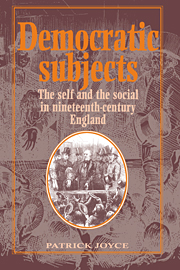Book contents
- Frontmatter
- Contents
- List of plates
- Acknowledgements
- Introduction
- Part One The sorrows of Edwin Waugh: a study in ‘working-class’ identity
- Part Two John Bright and the English people: a study in ‘middle-class’ identity
- 7 Plain man's prophecy
- 8 Speaking Bright
- 9 Making the self
- 10 Bright makes the social
- 11 Creating the democratic imaginary
- Part Three Democratic romances: narrative as collective identity in nineteenth-century England
- Appendices
- Index
11 - Creating the democratic imaginary
Published online by Cambridge University Press: 10 December 2009
- Frontmatter
- Contents
- List of plates
- Acknowledgements
- Introduction
- Part One The sorrows of Edwin Waugh: a study in ‘working-class’ identity
- Part Two John Bright and the English people: a study in ‘middle-class’ identity
- 7 Plain man's prophecy
- 8 Speaking Bright
- 9 Making the self
- 10 Bright makes the social
- 11 Creating the democratic imaginary
- Part Three Democratic romances: narrative as collective identity in nineteenth-century England
- Appendices
- Index
Summary
Bright and Gladstone were the two greatest popular political leaders of their day. The most recent study of Gladstone's leadership, that of Biagini, presents a figure similar to Bright in many respects. Their ‘charismatic’ leadership expressed the same mixture of familiarity and veneration, the description the ‘Grand Old Man’ summing this up for Gladstone. For Bright the combination of the figures of the plain man and the white-haired prophet of the moral law represented the same combination. The demotic implications of the persona of the plain man provided the shape of the future in the creation of the democratic imaginary, the reassurance of venerability delineated its past, the necessary counter-balance to hope. The wider significance of the cult of Bright as the plain man can therefore be appreciated: this dual nature of charismatic leadership was one of the central means by which a nascent mass democracy was both mobilised and managed.
For Biagini, in the sentimental vein of an ever-new Whig interpretation of British history, this new politics is without shadows and depths. It is about democracy, not demagogy. Gladstone is its hero, the man who equips Victorian Britain for democracy by fusing charismatic leadership and ‘rationalistic’ Liberalism in such a manner as to prevent authoritarianism and a bureaucratic party system.
- Type
- Chapter
- Information
- Democratic SubjectsThe Self and the Social in Nineteenth-Century England, pp. 136 - 146Publisher: Cambridge University PressPrint publication year: 1994



